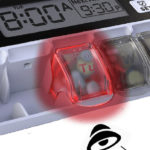Think you might have the coronavirus?
First, if you think you have the Wuhan coronavirus, call your health care professional or local public health department immediately. Second, tell the contact where you recently traveled . Third, list all the people you have come into contact with. Hence, if the doctor determines you may have the coronavirus actions will start to happen
Sponsored by Med-Q Automatic Pill Dispenser with Alarms and Timers

Risk of infection in the US relatively low compared to other countires
First, according to the CDC, only two cases of person-to-person transmission happened within US. The patients was someone who had traveled to China. Then, came back and infected a his wife. To sum up, 19 cases in the US cases have now been confirmed.
What to do if you think you’ve been exposed to the Wuhan coronavirus
Thee CDC and healthcare professionals have very specific directions. Call the Hospital before you do anything. Always, Stay at home and follow the doctor’s direction. Med-Q Pill quotes Dispenser with Alarms, Kim Leslie, an emergency-department nursing director at Swedish Hospital in Chicago, “If there’s no reason for you to seek emergency medical treatment, then stay at home and we will send you to the right place.”
First of all, tell the healthcare professional about any recent trips aboard. Second of all, list out all contacts you could have had with someone who got the Wuhan coronavirus. The doctor will usually arrange a secure transport to bring you to a qualified hospital. The goal, not exposing others people to the deadly virus. It does seem to be more communicable than our typical seasonal flu. Thus, very important to try to minimize other people’s exposure.
While you’re at home, the CDC has a few other recommendations
- Separate from other people. Use a different bathroom if you are able.
- Wear a face mask to cover mouth and nose.
- Cover coughs and sneezes with thick towels.
- Wash hands often for at least 25 seconds.
- Never, ever sharing things like dishware, towels, or sheets and pillows.
Call your doctor to determine whether you should visit a hospital
© Photo by Tomohiro Ohsumi/Getty ImagesWhen you call a doctor, the first thing they’ll want to know is where you’ve been and what your symptoms are. That basic information will help them determine whether you are actually at risk of the new coronavirus.
Patients have reported symptoms similar to those associated with pneumonia, such as fever, coughing, chills, headache, difficulty breathing, and a sore throat.
The virus can be transmitted between people through respiratory droplets such as saliva or mucus. It may be passed before a person shows symptoms.
If you have some of these symptoms and think you may have been exposed to the Wuhan coronavirus, your doctor will likely order a test for the virus. They will also ask about the severity of your symptoms to determine whether you should visit the hospital.
“We’re really using the same criteria that we would typically use day-to-day for persons with the flu or with other infections to determine whether or not they need to be hospitalized,” Martinello said.
For people in the US, the seasonal flu poses a much higher risk than the new coronavirus. Leslie said that her emergency department has been especially crowded lately because the flu is “on the rise.”
At least 19 million Americans contracted the flu in the last four months and 10,000 have died since October. The peak of flu season comes between December and February.
Patients who recently traveled to China get an isolation room
Last week, Leslie said, a man came into the emergency department at Swedish Hospital saying he was sick and had recently visited China.
The staff gave the man a face mask and ushered him into a “negative airflow” chamber that does not allow air to escape the room.
Many private doctor’s offices do not have these negative-airflow rooms, however, so potential coronavirus patients would probably get a room in the back, as far as possible from other patients. That’s what Martinello said his office did with one patient. The man’s condition wasn’t serious enough to be hospitalized, so the staff sent him home with a warning to stay in the house and wait for his test results. The test came back negative.
When treating the Chicago patient in the negative-airflow chamber, medical workers wore protective gear, including gloves, gowns, eye protection like goggles or a face shield, and an N95 respirator mask to protect them from virus-carrying droplets.
Infection-control experts asked that patient more personal questions, Leslie said. Epidemiologists typically inquire about whether a potential coronavirus patient recently had sex with anyone (especially while traveling), which specific locations they visited, who they had contact with, and what they did in each place they went.
“After that scrutiny, [he] did not meet the criteria to be concerned. So we lessened his level of isolation, out of that room, and considered him just your basic average flu,” Leslie said.
Even if a patient is confirmed to have the coronavirus, there is no specific medication for it. So, much like the flu, doctors simply treat patients’ symptoms, ensure they get enough oxygen, and keep them hydrated.
Officials are monitoring for more instances of person-to-person transmission in the US, but Martinello thinks the country’s risk is falling.
“Right now with how travel to and from China has been significantly restricted, I’m expecting that over the next week or two we’re really going to have fewer and fewer people who have recently come from China and been exposed to this coronavirus,” he said.


